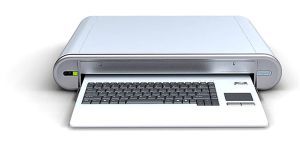Self-cleaning Computer Keyboard Approved for Use in Health Care Settings
In hospitals and other medical settings, any surface touched by multiple people can serve as a medium for spreading viruses and bacteria-even a computer keyboard. That's where the Vioguard self-sanitizing keyboard, which was approved for use in health care settings last week by the FDA, comes in.

In hospitals and other medical settings, any surface touched by multiple people can serve as a medium for spreading viruses and bacteria—even a computer keyboard. That’s where the Vioguard self-sanitizing keyboard, which was approved for use in health care settings last week by the US Food & Drug Administration (FDA), comes in.
"Conventional computer keyboards have been identified as a key point of transmission of viruses and bacteria, especially within the medical setting,” said Larry Ranta, president and CEO of Vioguard, in a press release. “The Vioguard keyboard takes the guesswork out of sanitization efforts, reduces labor costs, and helps fight the spread of harmful and often deadly superbugs."
This is the first FDA-cleared computer keyboard that sanitizes its surfaces by killing germs with ultraviolet light (UV-C). The cleansing process occurs automatically on a predetermined schedule, but can also be triggered manually.
The keyboard automatically retracts into a hygienic, light-tight enclosure where it is flooded with high-power UV light. In order to gain access to the keyboard when it is retracted, one waves a hand in front of a motion sensor and the motorized keyboard drawer opens, offering the sanitized keyboard for use.
The keyboard uses two 25-watt UV-C lamps with a reflector and diffuser to distribute the light evenly. According to the company’s press release, the UV light generated by the keyboard's lamps can kill a minimum of 99.99% of harmful bacteria and viruses such as E. coli, MRSA, and other pathogens.
The keyboard looks and feels like a standard notebook keyboard and requires no software or special hardware to operate. A microprocessor controls UV exposure and sensor function, and ensures that the lamps inside the cleaning device do not overheat.